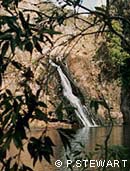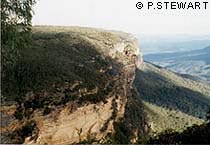Australia
is a continent of contrasting geography and
climate. The northern coast is a varied landscape
of rainforest, flood plains, mountains and
escarpment country. Waterfalls cascade from
mountains and plateaux to fill the coastal
wet-lands.
 |
| Kakadu |
|
|
Inland the
environment transforms from savanna
forest into the mulga woodlands, sand
dunes and grassy plains that cover most
of inland Australia. The
desert meets the sea over vast stretches
of the southern and western coast lines.
|
The Great
Dividing Range
The Great Dividing Range traces the coast from
the south east along the entire east coast to the
tip of Cape York disappearing into the sea and emerging
to form the Torres Strait Islands.
It is
an appropriately named mountain range as it
divides the dry inland from the wet coast. Where
it commences in the south adjacent to the
Antarctic ocean the mountains are sub-alpine and
snow bound in winter time. As it transits to
higher latitudes the environment becomes
increasingly tropical.
 |
| The
Great Dividing Range |
|
|
Most
non-Aboriginal people live in the south
east corner of Australia enjoying the
cool temperate climate of the coastal
plains produced by the warm currents of
the Pacific ocean. |
Northwards
Northwards following the Great Dividing Range,
the coastal fringe becomes increasingly tropical.
Aboriginal
people however occupy all parts of Australia and
in the more remote parts of the desert and the
tropical north form a large part and sometimes
are the majority of the population. One quarter
live in large cities. In the Northern Territory
they are 35% of the population outside of Darwin.
For further reading
on population see:
- Horton
p.889
- Comprehensive
data on population
is available in Hugo, G 1889-1991,
- Atlas
of the Australian
People, 8 vols, AGPS Canberra
|

